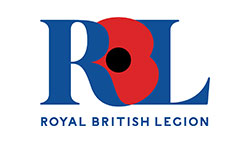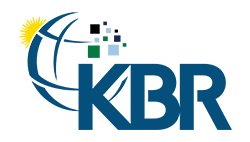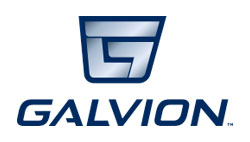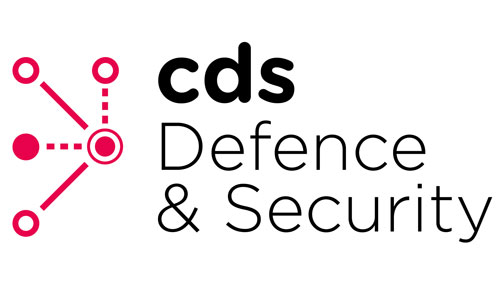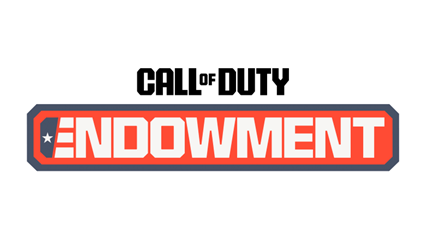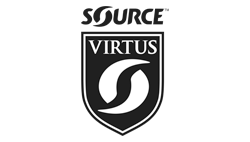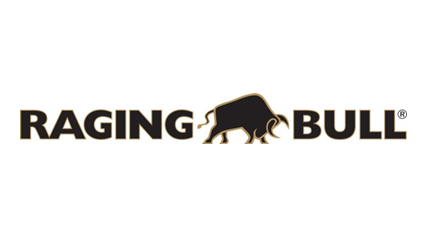The beginnings (1921)
After the First World War (1914-28) the Army Rugby Union (ARU) turned its attention to the question of referees for Army and Unit matches. The matter was recorded at Minute 6 of the General Committee Meeting on 29 November 1921 and read:
It was agreed that this was a matter of vital importance and, for the furtherance of Rugby on sound lines, it was necessary that not only should a sufficient number of officials within the Army exist but that uniformity should be obtained in the definition of the rules by the formation of a Central Army Rugby Referees Society. A sub-committee, as under, was appointed to take immediate steps for the setting up of such an organisation: Major B. C. Hartley, Army Sport Control Board, Capt. O. G. Philby, RMC Sandhurst, Capt A. H. MacIlwaine, RMA Woolwich and Major R. W. Ling, ASCB (Secretary).
First list of Army referees (1931)
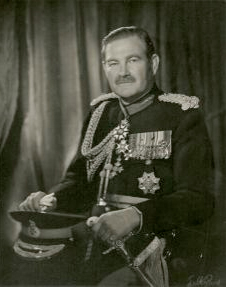
The first list of Army referees published in 1931 showed that there were sixty registered throughout the world. In the main these were officers but only a season later, in 1932, although the total had dropped to fifty-one, the ranks varied from Lieutenant-Colonel to Sergeant. The former H C (“Tiny”) Harrison, was an instructor at the Imperial Defence College and the latter, E Grainger, was serving in the Coldstream Guards. ‘Tiny’ Harrison’s career in Rugby was outstanding by any standards. He played for England from 1909 to 1914 and then took up refereeing. He emulated his success as a player with his selection to referee France versus Scotland in 1922 and, in 1928, he refereed the final of the Army Rugby Union Challenge Cup Competition (ARUCCC).
Many of the records for the years 1934 to 1942 were destroyed by fire during the Second World War (1939-45) but one interesting document for the year 1938 remains. The book Games and Sports in the Army was becoming more sophisticated year by year, and by the winter of 1938 was able to produce a supplementary list of referees by districts and commands world-wide. Included in this list are such illustrious names as the Rev V J Pike (Ireland 1931-34), 2nd Lieut D A Kendrew (England 1930-36) and Capt C K T Faithful (England 1924-26).
Also recorded at about this time is the name of Capt W D C Greenacre. He was the first Army referee to represent the ARU in the London Society of Referees. This was the beginning of what was to prove a most rewarding and profitable relationship on both sides and one which remains strong to the present day.
Army Rugby Union Referees Society founded (1939)
In 1939 Capt W D C Greenacre was selected as the first Chairman of the newly formed Army Rugby Union Referee Society (ARURS) .
In 1948 the ARURS was reconstituted and continued to function for the next seven years on a similar basis to that of pre-war years, under the Chairmanship of Brig T H Clarke (1948-49) and Lieut-Col R B S Eraut (1950-54). These were difficult years for referees. Not only was the standard or refereeing unsatisfactory, but records of referees and their qualifications were incomplete or non-existent. Nor was all well in the playing enclosure. More than once in those years was it necessary for the ARU and the ARURS to express displeasure over the standard of behaviour on the field.
Nevertheless, it was in those seven years that the ARURS put into effect an outline structure of the Society which remains virtually unchanged today. In 1950 three classes of referee were introduced. Until the early fifties it was accepted practise for Command Rugby representatives to act as members of the ARURS Committee; The Chairman of the ARURS was but an ex-officio member of the ARU and then only on those occasions when refereeing was discussed.
In September 1955 a meeting of Command representatives was called by Rev Ken Oliver as Chairman of the Society. For the first time the minutes of an Army referees meeting were produced and these records two interesting facts. Firstly, there still remained a number of referees who were neither qualified nor registered and it was quite clear that, if the ARURS was to function as such, referees must either be members or opt out of refereeing. Secondly, up to this date units were rarely notified of the names of qualified referees within their Commands. Action was taken on both points as the season progressed.
ARURS Join the ARU General Committee (1956)
In 1956 came the announcement by the ARU that the Chairman of the ARURS should henceforth be considered a full member of their General Committee. The referee was no longer a second-class citizen within the Army Rugby. The new status was to prove vital in the years to come as a great number and cross-section of all ranks participated in the game.
In the same year, with the Committee under its new Chairman, Col S Moore-Coulson, the ARURS expanded on the sound formula evolved in the previous season. This expansion was to have far reaching consequences, it is, therefore, important to dwell for a moment on the decisions taken.
First ARURS Dinner (1961)
Of importance in 1961 was the announcement in January of the first Society Dinner to be held in the following March at the famous ‘Printers Devil’, Fetter Lane. However, sadness tinged this great event since it was followed by the retirement of the Chairman, Moore-Coulson, now Maj-Gen, from the Committee and from the Army. In this short account, only too little space can be given to his achievements. He had overseen the transformation of the ARURS from a humdrum, if enthusiastic, body of referees of varying talent into a highly organised Society, finally and justly accepted in the higher grades by the County Panels. He handed over to Maj-Gen E B Stockdale.
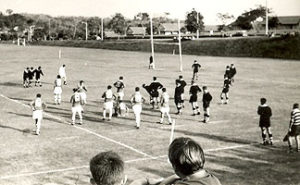
As the next few years passed it appears that the ARURS received plaudit upon plaudit. The Army was asked to provide a representative on the County Championship Referees panel and John Ledsham was selected for the Eastern Counties versus Middlesex match. At the same time he accepted an invitation to take over as Secretary of the ARURS.
John Ledsham assumed his duties in the following spring under the new Chairman, ‘Bun’ Cowey, now Brigadier. At his first meeting guide lines for the referees’ courses were laid down with a view to the first Annual Convention to be held in 1964, when there were to be considerable changes in the laws.
An astonishing decision of the Army Rugby Union in 1961, which ruled against the selection of Army referees as touch judges for Inter-Service games in which the Army were playing, was reversed in 1965 and at the same time a comparatively young officer, Capt Christ Tyler (later Brig Tyler, ARURS Chairman), made his first appearance in the minutes on being upgraded to Class 1. Anomalously, he had already been on the County Championship Panel from 1957 to 1959 but that was whilst with the Cambridge Society.
The next two years were a logical development of the previous three. Civilian societies boasted some sixty-four Army members and this figure did not include those who had failed to register with the Army for a variety of reasons. As the annual conventions developed with international panel referees and players as speakers, so did the number of exchange fixtures between Army and civilian societies, particularly in Berkshire, Kent, Dorset and Wilts, Hampshire, London and Sussex.
Improving Standards (1950s)
Certain County associates had made it clear to the Committee that the standard of senior Army referees did not match that of their County-grade referees. The remarks were neither ill-timed nor ill-considered. An unequivocal statement was made by the Chairman to the effect that only the Chairman of Command Rugby, one senior Army and one civilian referee of equivalent status could upgrade a referee to Class1; thus was taken the first major step towards obtaining the right standard of referee in top class Army Rugby. But it was one thing to restrict selection to Class 1, another to ensure that the right standard of referee was developed and encouraged at lower levels.
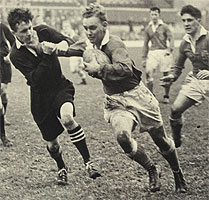 By early 1958 not only was the ARURS in a position to control its own members but it was able to ask the ARU to instruct units that only registered Army referees should be appointed to ARUCCC games. A position of some strength? Well, it was an improved one with 171 registered and graded referees and forty-one probationary members and it had become normal practice for at least one vacancy to be allotted to the ARURS for the annual national Rugby Football Referees’ course at Bisham Abbey.
By early 1958 not only was the ARURS in a position to control its own members but it was able to ask the ARU to instruct units that only registered Army referees should be appointed to ARUCCC games. A position of some strength? Well, it was an improved one with 171 registered and graded referees and forty-one probationary members and it had become normal practice for at least one vacancy to be allotted to the ARURS for the annual national Rugby Football Referees’ course at Bisham Abbey.
As the 1950s reached their close the records reveal the name of Maj John Ledsham who was to achieve wide recognition in later years. On this particular occasion, in 1959, he was appointed to referee the final of the ARUCCC. At the same time to the Committee was added a representative from Northern Ireland, another former international player, Capt D W Shutleworth (England 1951).
The ARURS moved in to the 1960s with, for the first time ever, a grand total of 301 referees registered and graded, a far cry from the original sixty in 1931. The decision of the Conference of County Referees to include Army personnel officiating in their areas on the County panel was followed swiftly by the selection of Maj Ledsham to the Cheshire County panel. As he made his first appearance in the records as the referee for the ARUCCC Final so did a comparative unknown of the time, WO2 Peter Lillington, appear as the nominated referee for the UK final.
Introduction of ARURS Newsletter (1967)
The standards of refereeing improved all the time but were never taken for granted. Going from strength to strength, the ARURS had the honour of providing the touch judge and reserve referee for the Combined Services versus Australia match, namely Chris Tyler. Of no small consequence at this time, 1967, was the decision of the ARURS to issue an annual Newsletter which was received with enthusiasm by all concerned and grew in popularity in the years to come. This year was also particularly notable for the advance made by the ARURS to recruit and build up junior ranks of referees. Some seventy per cent of Class II referees were appointed to senior fixtures and fifteen per cent of them were upgraded to Class I. At the same time referees were being strongly urged to join civilian societies, cementing the bond that had grown between them and the ARURS.
ARURS and the Development of the RFU Referee Advisory Panel
At this stage records must be made of the formation by the Rugby Football Union of its Referee Advisory Panel, which as its title suggests was responsible for advising the RFU Referee Sub-Committee on the appointments of referees. One representative was drawn from each of the five divisional areas of the County championships and one from the Combined Services. John Ledsham was primarily responsible for persuading the RFU to form the Panel, and it was most fitting that he was chosen to be its first Hon Secretary.
The work John Ledsham put in to further the recognition of rugby referees in general, and the ARURS in particular, was enormous. To mark this superlative contribution to Army rugby he was honoured by the award of the MBE on his retirement from the Army. The Secretaryship was taken over by Peter Lillington, now a Captain, who, having left the Dorset and Wilts area, was back in the fold and regularly represented the ARURS on and off the field of play at the highest levels.
In 1975 the RFU Referee Sub-Committee and its Advisory Panel devised a national scale of gradings. This was welcomed by the ARURS as it enabled them to move within the UK or return from overseas without always starting at the foot of any civilian society ‘ladder’.
Achievements (1970s and onwards)
Through the 1970s the ARURS scaled even greater heights by the achievements of its senior referees. Chris Tyler, in addition to refereeing many touring teams, accompanied the England XV on the 1971 Far East Tour; and Peter Lillington, now Major, and WO2 David Williams refereed at every senior standard up to ‘B’ Internationals. Peter Lillington remained on the A1 list for seven seasons and must have been very close indeed to the International Panel. For his outstanding services to Army rugby, he was elected an honorary Life Vice-President of the ARU.
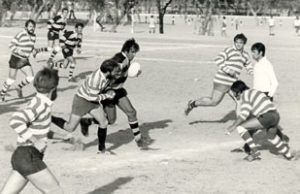 In the mid-eighties the ARURS face the future with confidence. The Annual Conventions deserve their national acclaim with vacancies on the being sought eagerly by civilian societies and by the RFU’s international referee guests. ARURS members are well established on the RFU ‘A’ Lists (now RFU Panel) and in the upper echelons of civilian societies. The foresight of that ARU Sub-Committee in 1921 has been well rewarded.
In the mid-eighties the ARURS face the future with confidence. The Annual Conventions deserve their national acclaim with vacancies on the being sought eagerly by civilian societies and by the RFU’s international referee guests. ARURS members are well established on the RFU ‘A’ Lists (now RFU Panel) and in the upper echelons of civilian societies. The foresight of that ARU Sub-Committee in 1921 has been well rewarded.
The success of the ARURS Annual convention continued through the eighties into the early nineties under the excellent leadership of Lt Colonel Bob Cannons. Bob was later to succeed Brigadier Chris Tyler (later Maj Gen) as Chairman ARURS, and continued to guide the Society through RFU referee grading changes and modernisation. Following his retirement from the Army, he was elected an honorary Life Vice-President of the ARU.
ARURS has continued to operate worldwide, and during recent times to officiate Army unit teams serving in operational hotspots such as Afghanistan, Balkans, Bosnia, Falklands, Iraq, and Kuwait.
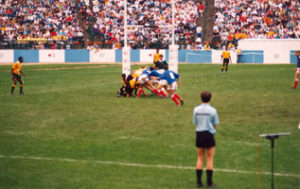 Whilst the majority of ARURS referees are concentrated in the UK, we do have a number of members serving in Germany. The senior list referees often travel back to the UK to officiate through the “exchange system” in search of the required level games in order to gain upgrading. Referees in Germany also have a good association with both national unions of Germany and Holland and assist on request in tournaments and rugby festivals.
Whilst the majority of ARURS referees are concentrated in the UK, we do have a number of members serving in Germany. The senior list referees often travel back to the UK to officiate through the “exchange system” in search of the required level games in order to gain upgrading. Referees in Germany also have a good association with both national unions of Germany and Holland and assist on request in tournaments and rugby festivals.
As part of the Combined Services Federation of Referees, ARURS members enjoy a wide variety of inter-services games, which provides referees at all levels a superb grounding to achieve promotion through the grades. ARURS members within the UK usually join a neighbouring civilian society to the unit where they are located.
The hospitality given to ARURS members by Civilian Societies over a great number of years has always been exceptional, and essential for those senior referees with aspirations for “top level refereeing”.
Source
McLaren Lt Col J: The History of Army Rugby (Aldershot, The Army RFU, 1986)
